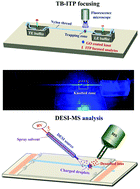Nanomaterial-assisted thread-based isotachophoresis with on-thread solute trapping†
Abstract
This research describes a nanomaterial-assisted thread-based isotachophoresis (TB-ITP) setup for the clean-up, preconcentration, and trapping of alkaloids (coptisine, berberine, and palmatine) in biological fluids, followed by their on-thread desorption electrospray ionization mass spectrometry (DESI-MS) determination. The reusable TB-ITP setup and a DESI compatible thread holder were 3D printed. A single nylon thread was employed as the ITP substrate for solute isolation and enrichment, and a short piece of graphene oxide (GO) functionalized nylon thread was tied around the main ‘separation’ thread as the ‘trap’ for the trapping of ITP focused alkaloids. Compared to the direct DESI-MS sample analysis, the sensitivity of the proposed method for the model solutes was increased up to 10-fold, benefiting from the TB-ITP focusing and enrichment strategy. This proof-of-concept use of nanomaterial-modified threads in electrofluidic separation and concentration procedures opens up a promising avenue to explore, particularly with regard to the sensitivity and selectivity of thread-based electrofluidic separation coupled with ambient ionization MS.



 Please wait while we load your content...
Please wait while we load your content...